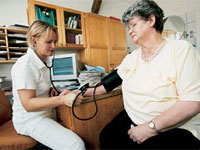American women suffer from hypertension
By Anastasia Tomazhenkova: A new survey shows uncontrolled hypertension rates are on the increase among American women. The prevalence of this major risk factor for heart disease and stroke among American men is still not as low as it should be.

Majid Ezzati, an associate professor of international health at the Harvard School of Public Health claimed that blood pressure that is higher than optimal is among the leading 2 or 3 risks for cardiovascular disease, if not the leading one.
About 1 in 5 American adults has "uncontrolled high blood pressure," defined as a systolic pressure - the higher number of the 140/90 reading - above 140, according to the state-by-state survey.
The trend among women is more alarming, with hypertension rates in the 1990s reversing and beginning to increase, researchers said.
Between the early 1990s and early 2000s, the prevalence of uncontrolled hypertension in adult women increased from 17 percent to more than 22 percent. At the same time, the rate of hypertension in men decreased from 19 percent to 17 percent. Even if blood pressure among American women had stayed at its levels of a decade ago, American women of different ages would have between 2 percent and 4 percent less heart disease and stroke.
There are big state-by-state differences, with the incidence of hypertension highest in southern states and the District of Columbia and with lower in Vermont, Minnesota, Connecticut, New Hampshire, Iowa and Colorado. They have rates between 15 percent and 16 percent for men and about 21 percent for women.
Ezzati noticed that in every state in the United States women have higher uncontrolled hypertension prevalence rates than men do. "The difference between men and women is as low as 4 percent and as high as 7 percent."
The persistent incidence of hypertension is "principally a failure of our health-care delivery system," said Dr. Dan Jones, president of the American Heart Association. "Certainly physicians have some fault, patients have some fault, and biology plays a role. But in our current health-care system, high blood pressure is treated as part of a visit with a primary-care physician that may take only five to 15 minutes. It may be one of five or six problems that the patient has and may be the least symptomatic of those problems, so it doesn't get the attention it should."
Even when the problem is detected and hypertension medication is prescribed, "patients need to take the medicine on a regular basis, and simply fail to do so," Jones said.
A diet high in fruits, vegetables, low-fat dairy products, reducing sodium, weight reduction, regular aerobic exercise, discontinuing tobacco smoking and alcochol drinking, relaxation therapy, such as meditation, that reduces environmental stress will help significantly lower blood pressure.
Subscribe to Pravda.Ru Telegram channel, Facebook, RSS!


